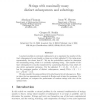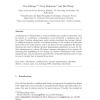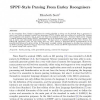113
Voted
SIAMDM
1998
15 years 11 hour ago
1998
For every string inclusion relation there are two optimization problems: find a longest string included in every string of a given finite language, and find a shortest string in...
93
Voted
COMBINATORICS
2004
15 years 6 days ago
2004
A natural problem in extremal combinatorics is to maximize the number of distinct subsequences for any length-n string over a finite alphabet ; this value grows exponentially, but...
154
click to vote
TCS
2008
15 years 8 days ago
2008
A subsequence is obtained from a string by deleting any number of characters; thus in contrast to a substring, a subsequence is not necessarily a contiguous part of the string. Co...
122
Voted
JIPS
2008
15 years 10 days ago
2008
: This research proposes a new strategy where documents are encoded into string vectors and modified version of KNN to be adaptable to string vectors for text categorization. Tradi...
JDA
2008
15 years 10 days ago
2008
For two strings a, b of lengths m, n respectively, the longest common subsequence (LCS) problem consists in comparing a and b by computing the length of their LCS. In this paper, ...
COMBINATORICS
2007
15 years 10 days ago
2007
In the last decade there has been an ongoing interest in string comparison problems; to a large extend the interest was stimulated by genome rearrangement problems in computationa...
IPL
2008
15 years 10 days ago
2008
We give two optimal linear-time algorithms for computing the Longest Previous Factor (LPF) array corresponding to a string w. For any position i in w, LPF[i] gives the length of th...
115
Voted
ENTCS
2006
15 years 11 days ago
2006
Families of Categorial Languages Makoto Kanazawa 1 National Institute of Informatics Tokyo, Japan We show that the class of string languages generated by abstract categorial gramm...
ENTCS
2008
15 years 13 days ago
2008
In its recogniser form, Earley's algorithm for testing whether a string can be derived from a grammar is worst case cubic on general context free grammars (CFG). Earley gave ...
CORR
2008
Springer
15 years 13 days ago
2008
Springer
The cornerstone of any algorithm computing all repetitions in a string of length n in O(n) time is the fact that the number of runs (or maximal repetitions) is O(n). We give a simp...



